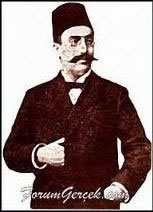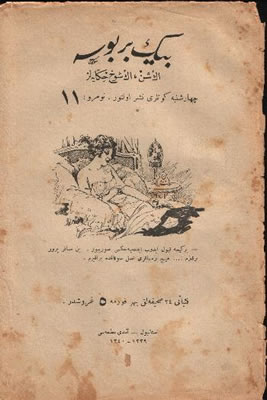NOVELS OF ILL REPUTE:
THE SECOND CONSTITUTIONAL ERA EROTIC LITERATURE
Burcu Karahan Richardson
Turkish Cultural Foundation Fellow (2010-2011)
Following the second proclamation of the Meşrutiyet (Constitution) in 1908, the Ottoman Empire witnessed a watershed of new publications, including a stunning six hundred new newspapers and journals. The social and political changes initiated by the newly acquired freedom did not merely lead to an increase in the number of publications, but also the type of publications. A popular new genre, erotic literature, spread from the capital across Anatolia.
Hundreds of erotic novels that were never included in the Ottoman and Turkish literary canons were frequently published and widely read from the early days of the Second Constitution to the first years of the Republic, between 1910 and 1925. Most popular novellas were published in two different series that carried the same name: “Bin Bir Buse” (the Thousand and One Kisses). Similar to the “Harlequin Romance Series” of the West, “Binbir Buse” series came out every Thursday with erotic novellas featuring suggestive titles such as Azgın (Horny), Anahtar Deliğinden (Through the Key Hole), İki Güzel Günahkar (Two Beautiful Sinners), Bir Bakirenin Gebeliği (Pregnancy of a Virgin), Üryan (Naked), and Bir Dakikalık Bekaret (Minute Long Virginity). One of these series featured anonymously written erotic stories, whereas the other published texts by well-known writers of the time. Although the identity of their publisher is not known, both series are attributed to Mehmet Rauf, the celebrated writer of Eylül (September) (1901) and a prominent member of the Edebiyat-ı Cedîde(New Literature) group. One of the “Bin Bir Buse” series featuring erotic stories by anonymous writers was republished in 2005 with an introduction by Irvin Cemil Schick. The other “Bin Bir Buse” series, however, is rare.

In addition to the market-oriented novels of the “Bin Bir Buse” series, there were a few erotic novels written by renowned writers such as Burhan Cahit, Selahaddin Enis, Selami İzzet, and Safaeddin Ziya. The first and the most widely read erotic novel of the time was Bir Zambak’ın Hikâyesi (The Story of a Lily), which was published anonymously in 1910 by Mehmet Rauf. The novel was also the first Turkish erotic novel that was banned and taken out of circulation by military court order. However, the novel was so popular among the public that its two editions were sold out shortly after publication. To supply the demand, publishers resorted to hiring people to hand write copies of Bir Zambak’ın Hikâyesi,and rented each copy for between 10 to 20 kuruş per night. Now, we know that hand-written copies of Bir Zambak’ın Hikâyesi became “pillow books” for many young men and women in the early 20th century in the Ottoman Empire.

Bir Zambak’ın Hikâyesi was a free translation or an “Ottomanized” version of French writer Marquise Mannoury d’Ectot’s third and final erotic novel Le Roman de Violette (1833). In his translation, Mehmet Rauf transforms this French decadent novel written from a female perspective on lesbian love into a Constitution era erotic text that celebrates male sexual power. In that sense, Bir Zambak’ın Hikâyesi sets an example for numerous (mainly French) erotic novels that had been altered in their Turkish translations.
In the majority of critical studies of the Constitution era literature, the emergence of erotic literature is explained by the radical changes in politics, and considered an isolated group of works that have no meaningful relation to the literary trends of the pre- or post-Constitution era. However, a close study of these novels reveals that the selective translation and adaptation techniques and character formation ideas applied by the writers emphasizes the continuation of the Tanzimat literary tradition that perceived and presented female characters as stereotypes of sexual slaves (i.e. concubines, and loose women or prostitutes) in order to affirm the position of Ottoman male protagonists against the West during an intense Westernization process imposed by the ruling elite.









